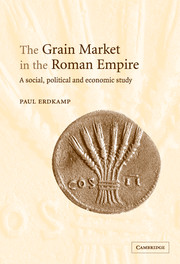Book contents
- Frontmatter
- Contents
- List of maps
- Acknowledgements
- Map 1 Asia Minor
- Map 2 Greece
- Map 3 Italy
- Map 4 The Roman World
- Map 5 Egypt
- Introduction
- 1 Production and productivity in Roman agriculture
- 2 The world of the smallholder
- 3 Farmers and their market relations
- 4 Market integration: connecting supply and demand
- 5 Rome and the corn provinces
- 6 Urban food supply and grain market intervention
- Conclusions
- References
- General index
- Index locorum
1 - Production and productivity in Roman agriculture
Published online by Cambridge University Press: 04 November 2009
- Frontmatter
- Contents
- List of maps
- Acknowledgements
- Map 1 Asia Minor
- Map 2 Greece
- Map 3 Italy
- Map 4 The Roman World
- Map 5 Egypt
- Introduction
- 1 Production and productivity in Roman agriculture
- 2 The world of the smallholder
- 3 Farmers and their market relations
- 4 Market integration: connecting supply and demand
- 5 Rome and the corn provinces
- 6 Urban food supply and grain market intervention
- Conclusions
- References
- General index
- Index locorum
Summary
It is a commonplace that in antiquity about 80 per cent of the population were engaged in agriculture, leaving only 20 per cent for all other sectors of the economy. Often a direct causal link is made between agricultural productivity and the division of labour, as for instance by H. Schneider in his assessment of ancient agriculture. He claims that, before the introduction of artificial fertilizer and machines, such as the combine harvester, agricultural productivity was extremely low: about 80 per cent of the population had to work the land in order to fulfil the entire society's needs for food and other agricultural produce. A direct link is made between a low level of agricultural productivity and the large proportion of people working the land. The estimate of the basic division of labour in the Roman world is undoubtedly generally about right. It is also correct to assign food supply a determining role in the structure and scale of the wider economy. However, it is wrong to see the limitations of agricultural production as an almost natural and inescapable barrier to further growth of the non-food producing sectors of the economy.
In an important study of the division of labour in pre-industrial France, G. W. Grantham has pointed out the discrepancy between the proportion of the population that was employed in agriculture and agricultural productivity.
- Type
- Chapter
- Information
- The Grain Market in the Roman EmpireA Social, Political and Economic Study, pp. 12 - 54Publisher: Cambridge University PressPrint publication year: 2005



